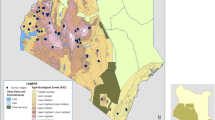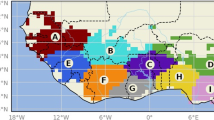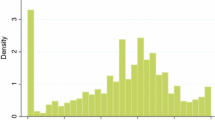Abstract
This paper concerns the patterns of food crop choice in a multicropping setting, in which production risk considerations and rainfall uncertainty are likely to be critical factors. The analysis employed plot level panel data from Ethiopia, combined with 30 year meteorological data corresponding to the survey villages used to construct seasonal and yearly rainfall variability. Using the single index approach, the riskiness of crop portfolio was constructed at a household level, taking into account the multicropping nature of the farming system. The combined riskiness of crops grown at a household level responded negatively to annual rainfall variability, with seasonal rainfall variability having a less consistent impact. Farmers are, therefore, more likely to select less risky crop portfolios even when intercrop interactions are taken into account.
Similar content being viewed by others
Notes
Although the focus of the paper is on the role of crop diversification as a mechanism of coping with weather risk, crop diversification could have other important purposes. In a situation where output markets work perfectly, production decisions are based solely on input and output price considerations and farm household consumption decisions are recursive to production decisions With imperfect output markets, however, there is imperfect substitution between market and home production, and recursive consumption decisions do not hold. Instead, the production and consumption decisions are made simultaneously and hence there is non-separability in production and consumption (de Janvry et al. 1991). Indeed, output market integration is identified as critical in the decision of households to diversify their crop choices (Van Dusen et al. 2007). This could be because, to the extent that the particular goods demanded by households are not available in the market, households will be forced to own-produce the goods. In addition, some varieties might have consumption qualities favored by particular localities but may not be widely produced and may have limited availability in the market which would prompt own production (Smale 1995).
In low income risk prone settings, crop biodiversity could be a critical resource that ensures efficient use of complementary resources and shields against natural risk. From an ecological perspective, increased species diversity contributes to an ecosystem’s performance through overall productivity, stability and facilitative interactions (Hooper et al. 2005 and Baumgartner 2007). Diversity increases productivity through increased likelihood of the presence of key productive species, enhanced complementarity between functionally different species and efficient use of available resources (Aarssen 1997; Loreau 2000). In addition, diversity enhances facilitative interaction between species, whereby certain species alleviate harsh environmental conditions or provide a critical resource for others (Mulder et al. 2001). Furthermore, diversity increases likelihood that species with different sensitivities to fluctuations are present thereby providing overall ecosystem stability (Borrvall et al. 2000).
It should be noted, however, that moisture stress is not the only characteristic that determines the riskiness (beta coefficient) of the crops. For instance, crops such as lentils have a low beta coefficient despite being drought sensitive. Similarly, sorghum and teff have high beta coefficients despite being drought tolerant.
Dercon (1996) argued that about 90 % of the difference in land allocation (to risky and less risky crops) between the poorest and the wealthiest groups of households was shown to be the result of asset differences. This result is also consistent with the study of the choice of investment portfolio in rural India conducted by Rosenzweig and Binswanger (1993).
Livestock, while theoretically part of the portfolio, are not included in our analysis (They are, instead, used as a control representing the wealth levels of households). The major reason for this is the difference in the decision time frame that involves choosing crop types and livestock. Crop production is a seasonal choice while livestock is a much longer term investment (seen by many as a way of saving, and an important component of agricultural input (particularly oxen)).
It should be noted that, while households diversify their crop choices, all the crops do not necessarily coexist in the same households. This is particularly attributed to the different crops being grown in different elevation belts commonly known as Dega (high elevation), Woina Dega (medium elevation), and Kola (low elevation).
For details on the derivation of the single index measure and differences in the nature of the data used in Turvey (1991) and our analysis, see Appendix 1.
Due to the difficulties of limited numbers of observations in obtaining sensible estimates for the crop riskiness measures of minor crops, theses were put into the “other” group category. Hence, any household growing one or more of these minor crops would have the beta risk coefficients calculated based on groupings in the “other” category.
As the beta regression is based on yield, the area allotment is taken into account as the denominator of the dependent variable in Eq. 1.
The thin plate spline technique was used for interpolation, the coding of which was done in the statistical programming software, R.
Meher season (approximately June-September) crops harvested in September-December make up the bulk of food production (90–95 %), the belg is the short rainy season, which extends from February to May and Belg production typically accounts for only 5–10 % of total annual production (CSA 2001).
The tropical livestock units are given weights based on the type of livestock reported by the household. The weights range from 1.25 for a horse to 0.125 for chicken.
The soil types identified in the survey were fertile, medium fertile and infertile. In addition the soil colours were categorized as red, black and white (grey). In the analysis, we added fertile and red soil categories using the other categories as baselines.
For details on the derivation of the estimable equation, see Di Falco and Chavas (2009).
It should be noted that R it takes two distinct measures in our analysis: the beta coefficient and the risk ranking measure.
It should be noted that the strict exogeneity assumption on the observed covariates conditional on α h is maintained although the arbitrary correlation between the two is allowed in this case. This implies that the observed covariates only contain time varying explanatory variables.
References
Aarssen, L. (1997). High productivity in grassland ecosystems: affected by species diversity or productive species? Oikos, 80, 183–184.
Amede, T., Belachew, T., & Geta, E. (2001). Reversing the degradation of arable land in the Ethiopian Highlands. Managing Africa’s soil No. 23. IIED, London.
Baltagi, B. H. (2001). Econometric Analysis of Panel Data. 2d ed. New York: John Wiley & Sons.
Barrett, C. B., Barnett, B. J., Carter, M. R., Chantarat, S., Hansen, J. W., Mude, A. G., Osgood, D. E., Skees, J. R., Turvey, C. G., & Ward, M. N. (2007). Poverty Traps and Climate Risk: Limitations and Opportunities of Index-Based Risk Financing. Paper prepared for the Policy Roundtable on Climate Risk, Poverty Traps and Index-Based Financing, hosted by the International Research Institute for Climate and Society, Columbia University, September 2007.
Baumgartner, S. (2007). The insurance value of biodiversity in the provision of ecosystem services. Natural Resource Modeling, 20(1), 87–127.
Borrvall, C., Ebenman, B., & Jonsson, T. (2000). Biodiversity lessens the risk of cascading extinction in model food webs. Ecology Letters, 3(2), 131–136.
Benin, S., Smale, M., Pender, J., Gebremedhin, B., & Ehui, S. (2004). The economic determinants of cereal crop diversity on farms in the Ethiopian highlands. Agricultural Economics, 31(2–3), 197–208.
Corbeels, M., Shiferaw, A., & Haile, M. (2000). Farmers’ knowledge of soil fertility and local management strategies in Tigray, Ethiopia. Managing Africa’s soils No. 10 IIED, London.
CSA (2001). Ethiopian Agricultural Sample Enumeration: Statistical Report on Farm management practices, Livestock and Farm Implements. Addis Abeba
de Janvry, A., et al. (1991). Peasant household behaviour with missing markets: some paradoxes explained. Economic Journal, 101(409), 1400–1417.
Deressa, T. R., Hassan, T., Alemu, M. Y., & Ringler, C. (2009). Analyzing the determinants of Farmers’ choice of adaptation methods and perceptions of climate change in the Nile Basin of Ethiopia. Global Environmental Change, 49, 248–255.
Dercon, S. (1996). Risk, crop choice, and savings: evidence from Tanzania. Economic Development and Cultural Change, 44(3), 485–513.
Dercon, S. (2002). Income risk, coping strategies, and safety nets. World Bank Research Observer. Oxford University Press, vol. 17(2):141–166.
Di Falco, S., & Chavas J.-P. (2009). On crop biodiversity, risk exposure and food security in the highlands of Ethiopia. American Journal of Agricultural Economics, 91(3), 599–611.
Eggenberger, W., & Hunde M. (2001) Belg Season in North-Central Ethiopia: Rains late but farmers remain optimistic. Report of a joint UN-EUE/MoA/FAO mission undertaken (from 19–29 March 2000).
Fafchamps, M. (1992). Cash crop production, food price volatility and rural market integration in the third world. American Journal of Agricultural Economics, 74(1), 90–99.
Haile, N. (2007). An economic analysis of farmers’ risk attitudes and farm households’ responses to rainfall Risk in Tigray Northern Ethiopia. Ph.D. Thesis, Wageningen University.
Hooper, D. U., Chapin, F. S., III, Ewel, J. J., Hector, A., Inchausti, P., Lavorel, S., Lawton, J. H., Lodge, D. M., Loreau, M., Naeem, S., Schmid, B., Setala, H., Symstad, A. J., Vandermeer, J., & Wardle, D. A. (2005). Effects of biodiversity on ecosystem functioning: a consensus of current knowledge. Ecol. Monogr., 75(1), 3–35.
Isik, M. (2002). Variable rate nitrogen application under uncertainty: implications for profitability and Nitrigen Use. Journal of Agricultural and Resource Economics, 27, 61–76.
Kates, R. W. (2000). Cautionary tales: adaptation and the global poor. Climatic Change, 45, 5–17.
Kurosaki, T., & Fafchamps, M. (2002). Insurance market efficiency and crop choices in Pakistan. Journal of Development Economics, 67(2), 419.
Kurukulasuriya, P., & Mendelsohn, R. (2006). Crop selection: Adapting to climate change in Africa, CEEPA Discussion Paper No. 26,CEEPA, University of Pretoria.
Kurukulasuriya, P., Mendelsohn, R., Hassan, R., Benhin, J., Diop, M., Eid, H. M., Fosu, K. Y., Gbetibouo, G., Jain, S., Mahamadou, A., El-Marsafawy, S., Ouda, S., Ouedraogo, M., Sène, I., Maddision, D., Seo, N., & Dinar, A. (2006). Will African agriculture survive climate change? World Bank Economic Review, 20(3), 367–388.
Loreau, M. (2000). Biodiversity and ecosystem functioning: recent theoretical advances. Oikos, 91, 3–17.
MoFED (Ministry of Finance and Economic Development), Federal Democratic Republic of Ethiopia. (2006). Ethiopia: Building on progress: A plan for accelerated and sustained development to end poverty. Addis Ababa: MoFED.
Morduch, J. (2002). Consumption smoothing across space: Testing theories of risk-sharing in the ICRISAT study region of South India, Working Papers UNU-WIDER Research Paper, World Institute for Development Economic Research (UNU-WIDER).
Mulder, C., Uliassi, D., & Doak, D. (2001). Physical stress and diversity- productivity relationships: the role of positive interactions. Proceedings of the National Academy of Sciences of the United States of America, 98(12), 6704–6708.
Mundlak, Y. (1978). On the pooling of time series and cross-section data. Econometrica, 46, 69–85.
Reilly, J., & Schimmelpfennig, D. (1999). Agricultural impact assessment, vulnerability, and the scope for adaptation. Climatic Change, 43, 745–788.
Reilly, J. (1996). Agriculture in a changing climate: Impacts and adaptations. In R. T. Watson, M. C. Zinyowera, & R. H. Moss (Eds.), Climate change 1995: Impacts, adaptations and mitigation of climate change: Scientific-technical analyses (pp. 427–467). Cambridge: Cambridge University Press.
Rosenzweig, M. R., & Binswanger, H. P. (1993). Wealth, weather risk and the composition and profitability of agricultural investments. Economic Journal, 103, 56–78
Rosenzweig, C., & Parry, M. L. (1994). Potential impact of climate change on world food supply. Nature, 367, 133–138.
Seo, N., & Mendelsohn, R. (2008). Measuring impacts and adaptations to climate change: a structural ricardian model of African livestock management. Agricultural Economics, 38, 1–15.
Smale, M. 1995. Understanding Wheat Genetic Diversity and International Flows of Genetic Resources. Part 1 of CIMMYT World Wheat Facts and Trends Supplement, 1995. Mexico, D.F.: CIMMYT.
Turvey, C. (1991). Regional farm level risk analyses with the single index model. Northeastern Journal of Agricultural and Resource Economics, 20(2), 181–188.
Van Dusen, E., Gauchan, D., et al. (2007). On-farm conservation of rice biodiversity in Nepal: a simultaneous estimation approach. Journal of Agricultural Economics, 58(2), 242–259.
Wooldridge, J. M. (2002). Econometric Analysis of cross section and panel data. Cambridge, MA, USA: Massachusetts Institute of Technology.
World Bank (2008) Ethiopia: Climate Factsheet, Washington DC: World Bank, http://siteresources.worldbank.org/INTAFRICA/Resources/Ethiopia_Country_Note.pdf.
Yesuf, M., & Bluffstone, R. (2009). Poverty, risk aversion and path dependence in low income countries: experimental evidence from Ethiopia. American Journal of Agricultural Economics, 91(4), 1022–1037.
Author information
Authors and Affiliations
Corresponding author
Additional information
We would like to thank the anonymous reviewers and Richard Strange for comments and suggestions. The usual disclaimer applies.
Appendix: The single index method measuring the riskiness of crop portfolio at the household level
Appendix: The single index method measuring the riskiness of crop portfolio at the household level
Equation 1a specifies the relationship between the reference portfolio revenue, and the individual crop revenue
Where S k is the reference portfolio, X i is the weight of enterprise (crop) i, and S i stand for the stochastic revenue of crop i.
Similarly, the revenue variance-covariance relationships between the reference portfolio and the individual crop revenues are given by:
where z K 2 is variance of the revenue corresponding to the reference portfolio, z ij and the covariance of the individual crop revenues. This equation captures the essence of the single index method—that the portfolio risk measures the proportionate contribution of an individual enterprise’s risk to the variance of the underlying index.
From Eq. 2a, the marginal risk—the contribution that each crop makes to portfolio variance is computed. This is given by:
Our parameter of interest, the anticipated changes in the revenues of a commodity in response to changes in portfolio returns, beta, is given in Eq. 4a.
This parameter is retrieved from regressions of S ih on the underlying reference portfolio, S kh , are the characteristic equations that determine systematic and non-systematic risk
Where α i is the intercept and β i is the regression coefficient, and e it is the error term. For simplicity, the weights d i are kept to 1 (equal weights).
The beta parameter estimated then measures the riskiness of each crop. Averaging over the beta coefficients estimated for each crop within the household gives the riskiness of the overall crop portfolio of the household.
In Turvey (1991), the basis of the empirical approach for our paper, the unit of analysis in their study is the county. Therefore, Eq. 5a is estimated using time-series data to generate, a county-beta. In our case, as we set out to estimate beta for each crop within the household, our unit of analysis is essentially the plot (crop type) within each household, for which we have a plot level observations for about 1,500 households over the four survey years. As a result, unlike Turvey (1991) OLS estimation of Eq. 5a using time series data, our estimation is an estimation of panel data (time subscripts representing years are suppressed for notational convenience). In order to take advantage of the panel feature of our data, (and to circumvent the effect of the beta coefficient picking up the effect of variation across households), we estimate Eq. 5a using a household fixed effects estimator.
In sum while we have the advantage of larger numbers of observations across households, our panel is short making time series estimation impossible. It should be noted that using time series data for such estimations is difficult in our setting and we are not aware of any such data at the plot level in a multicropping farm context in Ethiopia. Even our detailed plot level data collected over 4 years is very rare. This is the first step in trying to measure riskiness using this methodology. Future studies need to look into using much richer sources of data.
Rights and permissions
About this article
Cite this article
Bezabih, M., Di Falco, S. Rainfall variability and food crop portfolio choice: evidence from Ethiopia. Food Sec. 4, 557–567 (2012). https://doi.org/10.1007/s12571-012-0219-7
Received:
Accepted:
Published:
Issue Date:
DOI: https://doi.org/10.1007/s12571-012-0219-7




